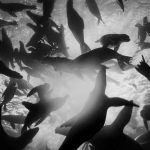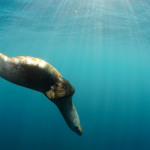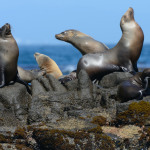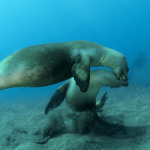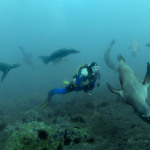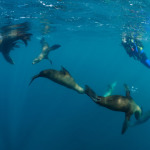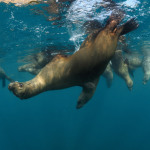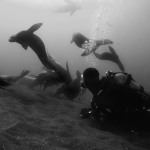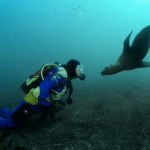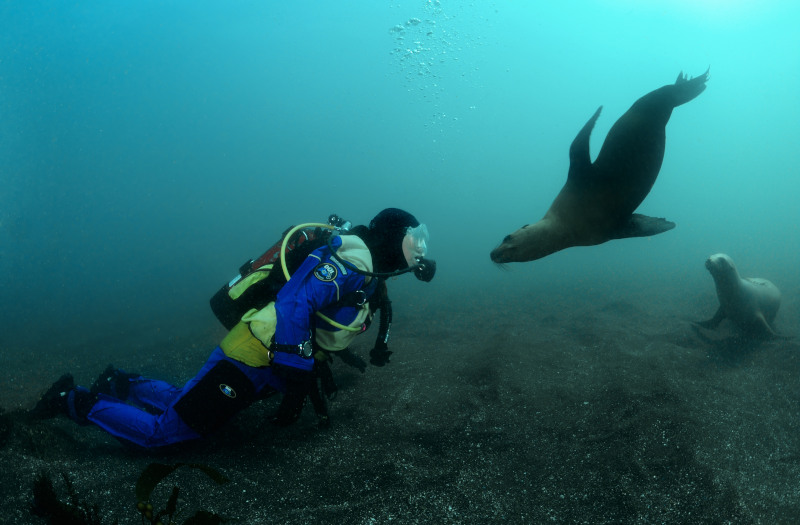
They came from every direction at once. Over a hundred and fifty living torpedoes darted and zoomed passed with incredible agility and purpose. They nipped our fins, grabbed our hoods, and tried to make off with our cameras. The pinnipeds were so thick I couldn’t tell the fate of my dive partner, but by this time it was every Homo aquaticus for themselves. I was near a small crevice and briefly considered trying to stuff myself into it, but finally decided to buck up and take it like a man, when as suddenly as they appeared – they vanished. The visibility was a good 50 feet and all I saw were a few hind flippers being swallowed up by the blue void. Now, we were sitting at 65 feet in Great White country, all alone, with only some sea mammal poop floating around wondering about Nature’s “subtle” warning signs of danger. After 20 -30 seconds, that seemed much longer, the reef fishes came out from their hiding places, we regained our composure and oceanic life returned to normalcy.
—————————————————————————-
Words & Photos by Joe Dovala, Dovala Images
—————————————————————————-
Although whitey never showed, our toothy smiles shone from behind our regulators and I was loudly humming “While walking through the park one day…” all the way back to our boat. Seal and sea lion encounters are fairly common around the Southern California off-shore islands. Although in over thirty-five years of diving I’ve never experienced anything quite like this meeting.
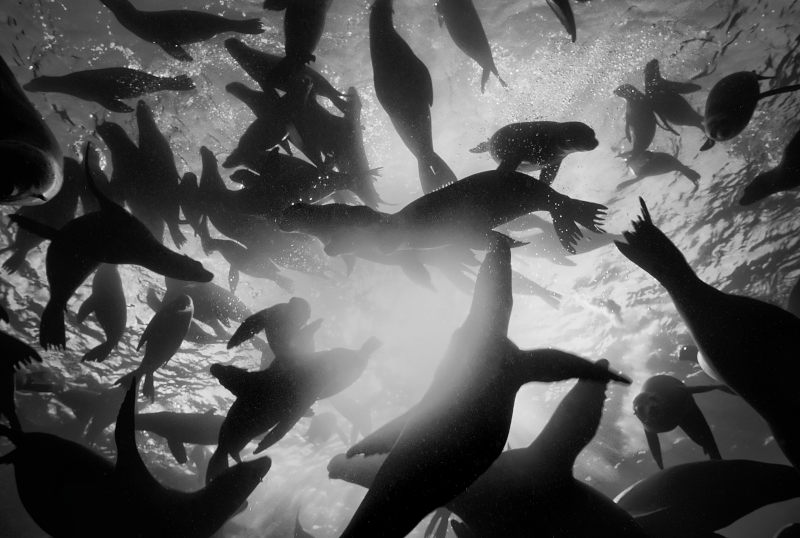
There are seven islands and three jutting rocks that reside within the Southern California Bight. This is so named because of a unique geography that allows for much calmer sea conditions than one would expect without it. If you take a look at a map of California, it looks like someone took a big mouthful of the North American tectonic plate from Point Conception to the Mexican border and then left behind a few rocky crumbs surrounded by the Pacific Ocean. The area is known for its variety of sea life and distinct underwater topography. It is also within a few hours travel time of over 20 million people crammed on or near the Southern California coast. Within this patch of ocean somewhere around 35,000 California sea lions (Zalophus californiaus) roam.
The sociability and playfulness of sea lions makes them an easy and favorite circus clown for water theme parks. Although often mistakenly called seals, most of the performers are in fact sea lions. Sea lions differ from seals both in physical attributes and behavior. They have external ears, slender snouts, and larger fore flippers. The hind flippers have also been modified to turn forward which helps locomotion on dry land. It is amazing how fast an angry bull can move if he thinks you’re eyeing one of his harem ladies. Sea lions are very social animals, with considerable numbers not only hanging out on land but also forming “rafts” on the ocean. These congregations provide security and an in water communal event. Our encounter must have been with the sea mammal version of an aircraft carrier. Seals, primarily harbor seals in Southern California, tend to be more solitary and usually like to observe divers from farther away and under cover. They seem to have a much more laid back manner in contrast to the rapid – gotta go – late for somewhere – actions of their sea lion cousins.
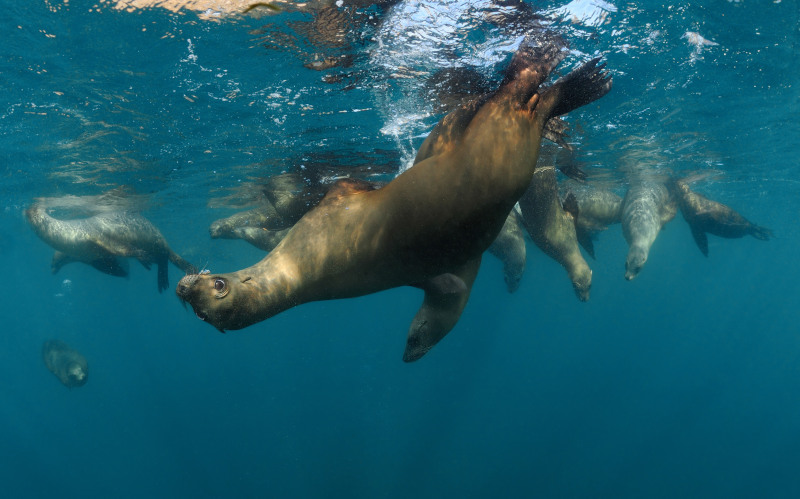
Sea lion pups are primarily born in summer and spend six months to as much as a year living on their mother’s labors (though nowhere near as long as some of my friend’s offspring). With not much else to do all day but play, large groups of these curious youngsters are easily attracted to anchored boats and divers. Often the dominant bull, who can push the scales at nearly 1000 pounds (another good reason not to get caught checking his babes out), will swim by first to make sure it’s safe then give the green light for the sea lion games to begin. The bolder youngin’s will make fly bys to see how agile you are and become even more daring when they realize how inept divers are in their world. The fly bys quickly become games of chicken, pinniped style. At speeds of over twenty miles an hour, with limited visibility, often your only clue is a brown streak with a bunch of bubbles barked inches in front of your face. Some of the more shy animals will just hang out and watch, occasionally diving to the bottom to retrieve a sea cucumber or piece of debris to see if you’re interested in a game of catch. While watching these antics it is easy to see why the military has the “real” version of the seals drafted in their ranks as well. In fact, nearly two dozen of these sardine loving UDT divers are on patrol in the Middle East right now. The marine mammals perform a myriad of tasks including patrol, recovery, reconnaissance, and sentry duty. Able to make repeated dives to over 900 feet, they can track down an enemy frogman, clamp a float to his leg, and if need be, chase him up on land all the while barking up a storm signaling his/her human counterpart. Call me “chicken-of-the-sea” but I, for one, would not want even a small sea lion after me in any serious fashion.
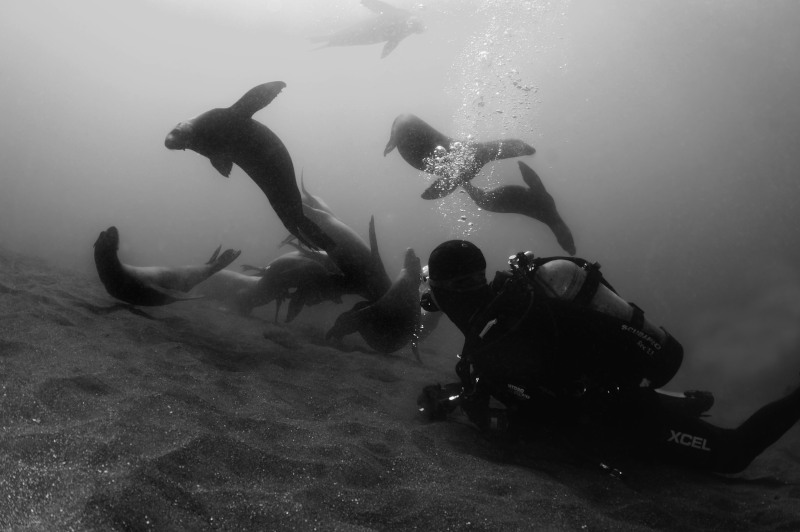
California sea lion populations appear to be growing in number and are able to withstand a considerable amount of human encroachment and oppression. Being opportunistic feeders they will munch on a number of fishes including octopus and some crustaceans. While their numbers have been increasing there has been concern about the overall health of the animals. Heavy fishing pressure on their preferred diet of herring and anchovies has severely reduced this food source. These fishes provide the healthy (at least for sea lions) high caloric content needed for their active lifestyle. Also, enormous amounts of run off pollution from the excessive human population (and still growing) of California are starting to show the cumulative deleterious effects common in apex predators. Some of the results of this problem are compromised immune systems, illness such as domoic acid seizures (caused from abnormal amounts of diatom blooms, both natural and fertilizer runoff), bacterial infections, and of course, increased conflict with fishermen over dwindling fish populations. Despite listed as “protected” many sea lions wash up on beaches with gun shot wounds. One such conflict made the evening news over the steeleye salmon fishery in Washington. A “gang” of sea lions with a supposed “ringleader” were being blamed for excessive take of fish (yes, of course, it must be the sea lions reducing the fish in the ocean – couldn’t possibly be the 90,000,000 metric tons of marine life ripped out by man every year). There was a plan to assassinate the main culprit but instead he was captured and incarcerated at Sea World.
I can’t help but think of my dog when I am the subject of a sea lion’s curiosity. They seem to live by the same basic code of finding joy in something as simple as a good sniff. They are intelligent with very distinct personalities and are a real joy to interact with. To be sure they are wild animals, yet being able to share the often-memorable encounters with them, in their world, is an amazing experience and should not be taken for granted.
—————————————————————————-
Words & Photos by Joe Dovala, Dovala Images
—————————————————————————-

